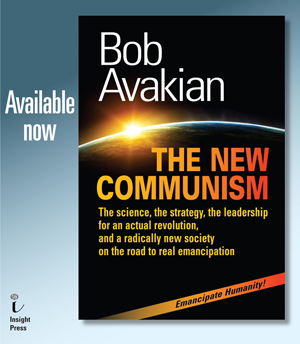
Editors' note: The following is an excerpt from the new work by Bob Avakian, THE NEW COMMUNISM. In addition to excerpts already posted on revcom.us, we will be running further excerpts from time to time on both revcom.us and in Revolution newspaper. TThese excerpts should serve as encouragement and inspiration for people to get into the work as a whole, which is available as a book from Insight Press. A prepublication copy is available on line at revcom.us.
This excerpt comes from the section titled "II. Socialism and the Advance to Communism: A Radically Different Way the World Could Be, A Road to Real Emancipation."
Excerpt from the section:
Internationalism
In this polemic by the OCR of Mexico, which is in Demarcations #4, they discuss both the material basis and the ideological basis for internationalism. The material basis being the fact that there’s a whole world system and not just a bunch of different systems within different particular countries, all self-contained, that somehow then interact with each other on the foundation of their essential self-containment. So that’s the material basis of internationalism. There’s the operation of the system of imperialism on a world scale. It operates economically, and that has real effects on people, sometimes even driving people in the millions from one country all the way to other parts of the world (coming from Nepal, or someplace else, they end up working in Bahrain, in 120 degree weather, dying in the heat). And this world system operates not only economically but also politically and diplomatically. It operates militarily. All that, on a world scale, in an overall and fundamental sense, is setting the stage for what we have to do—setting the stage, as the principal aspect, in dialectical relation with the struggles of various kinds that this gives rise to—and, above all, the revolutionary struggles of the masses of people, especially as they are led by conscious and organized communist forces.
But then the OCR polemic also speaks about the ideological basis for internationalism (the ideological basis meaning the way, or method, of thinking). Mao made the point in one of his important philosophical works, “On Contradiction,”40 that it is the internal contradictions within a thing that provide the basis for it to change. He gave the example of an egg and a stone: an egg, at the right temperature, can produce a living being, but a stone cannot. Why? Because of the internal contradictions and dynamics within the one and the other. Because of its internal nature, a stone does not have the basis to produce a living being, and no matter how much you heat it up, it’s not going to produce one. Mao used this as an example to illustrate that internal contradictions are the basis for change within a thing. And he made the point, using this same example, that the temperature that might be applied to an egg can be the immediate cause of change, it is an external condition which can be a cause of the change, but it’s not the fundamental basis for the change. It’s like heating up water. The reason water can turn into steam is because of the internal nature of, and the internal contradiction within, water. The heating is the immediate cause of the change, while the internal nature of water is the basis for the change. So this was an important point made by Mao. But, unfortunately, at times he applied this in a kind of one-sided way, beyond the point where it was correct. Let me put it this way: Even while Mao was fundamentally internationalist, there was a tendency in Mao to say that each country has its own internal contradictions and that’s the fundamental basis for revolution within that country. He was applying the principle that the internal contradictions are the basis for change—which is a correct and very important principle, and something that was not clearly grasped and acted upon in the communist movement up to that point (it’s not that there was no understanding of that, but there was still a lot of unclarity about that). But the problem is that, in the era of capitalist imperialism, internal contradiction applies differently.
This is another one of those complexities—there are different levels of the organization of matter. A country, to put it simply, is one level of the organization of matter—countries and the people in them (and everything else in them) are made up of matter in motion, in many different forms. The world arena, the world as a whole, is another level of the organization of matter. So, in one sense, or on one level, the internal contradictions within a country are the basis for it to change, but in turn that country is part of a larger whole, the larger world, and it’s the internal contradictions of that larger world as a whole which are, in the final analysis, more determining, even of what happens within a particular country.
To illustrate this, an example that’s used in this polemic by the OCR of Mexico is the human body, and the different levels of the organization of matter in the human body (this example was used in an article of mine, “‘Crises in Physics,’ Crises in Philosophy and Politics,”41 which is found in Demarcations #1, and it was also used in this OCR polemic). The human body is made up of a lot of different cells, and it’s made up of different organs—the liver, the kidney, the heart, and so on and so forth. Each of those particular levels of the organization of matter have their own internal contradictions—kidneys have their own internal contradictions, livers have their own internal contradictions, the same with the heart, and so on. But, in turn, they’re part of a larger body, and what is happening to that larger body (or the person as a whole) is, in an overall sense, more determining of what happens even to those internal organs than just the internal contradictions of those internal organs themselves. Now, here’s the complexity of it, once again: it’s not like the internal organs don’t affect the body as a whole. If you have contradictions that cause your heart to fail, it’s obviously going to affect your whole body. And the same with other organs, like your liver or your kidney. So there is, once again, a contradictory, a dialectical, relation. But overall, the body—the person as a whole—interacting with the larger environment, is the entity that is most determining; the contradictions within that body are mainly what determines what happens to the body as a whole, even though, at a particular time, what’s happening to a particular organ of the body—based on its internal contradictions, in interaction with the rest of the body and with the larger environment—can become the concentration point of what’s happening to your body as a whole, just like a particular country in the world can become the concentration point of the contradictions in the world.
40. Mao Tsetung, “On Contradiction,” 1937. [back]
41. Bob Avakian, “‘Crises in Physics,’ Crises in Philosophy and Politics,” in Demarcations: A Journal of Communist Theory and Polemic, Issue Number 1, Summer-Fall 2009. Originally appeared in Revolution #161, April 12, 2009. Available at demarcations-journal.org and revcom.us. [back]
Contents
Publisher's Note
Introduction and Orientation
Foolish Victims of Deceit, and Self-Deceit
Part I. Method and Approach, Communism as a Science
Materialism vs. Idealism
Dialectical Materialism
Through Which Mode of Production
The Basic Contradictions and Dynamics of Capitalism
The New Synthesis of Communism
The Basis for Revolution
Epistemology and Morality, Objective Truth and Relativist Nonsense
Self and a “Consumerist” Approach to Ideas
What Is Your Life Going to Be About?—Raising People’s Sights
Part II. Socialism and the Advance to Communism:
A Radically Different Way the World Could Be, A Road to Real Emancipation
The “4 Alls”
Beyond the Narrow Horizon of Bourgeois Right
Socialism as an Economic System and a Political System—And a Transition to Communism
Internationalism
Abundance, Revolution, and the Advance to Communism—A Dialectical Materialist Understanding
The Importance of the “Parachute Point”—Even Now, and Even More With An Actual Revolution
The Constitution for the New Socialist Republic in North America—
Solid Core with a Lot of Elasticity on the Basis of the Solid Core
Emancipators of Humanity
Part III. The Strategic Approach to An Actual Revolution
One Overall Strategic Approach
Hastening While Awaiting
Forces For Revolution
Separation of the Communist Movement from the Labor Movement, Driving Forces for Revolution
National Liberation and Proletarian Revolution
The Strategic Importance of the Struggle for the Emancipation of Women
The United Front under the Leadership of the Proletariat
Youth, Students and the Intelligentsia
Struggling Against Petit Bourgeois Modes of Thinking, While Maintaining the Correct Strategic Orientation
The “Two Maximizings”
The “5 Stops”
The Two Mainstays
Returning to "On the Possibility of Revolution"
Internationalism—Revolutionary Defeatism
Internationalism and an International Dimension
Internationalism—Bringing Forward Another Way
Popularizing the Strategy
Fundamental Orientation
Part IV. The Leadership We Need
The Decisive Role of Leadership
A Leading Core of Intellectuals—and the Contradictions Bound Up with This
Another Kind of “Pyramid”
The Cultural Revolution Within the RCP
The Need for Communists to Be Communists
A Fundamentally Antagonistic Relation—and the Crucial Implications of That
Strengthening the Party—Qualitatively as well as Quantitatively
Forms of Revolutionary Organization, and the “Ohio”
Statesmen, and Strategic Commanders
Methods of Leadership, the Science and the “Art” of Leadership
Working Back from “On the Possibility”—
Another Application of “Solid Core with a Lot of Elasticity on the Basis of the Solid Core”
Appendix 1:
The New Synthesis of Communism:
Fundamental Orientation, Method and Approach,
and Core Elements—An Outline
by Bob Avakian
Appendix 2:
Framework and Guidelines for Study and Discussion
Notes
Selected List of Works Cited
About the Author
 Download PDF of entire work
Download PDF of entire work